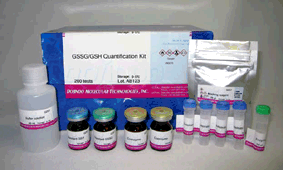DTCS Na

NO Detection
-
Product codeD465 DTCS Na
-
CAS No.13442-87-0
-
Chemical nameN-(DithiOcarboxy)sarcosine, disodium salt, dihydrate
-
MWC4H5NNa2O2S2・2H2O=245.23
| Unit size | Price | Item Code |
|---|---|---|
| 100 mg | $154.00 | D465-10 |
Product Description
Diethyldithiocarbamate (DETC) is a good spin-trapping reagent for nitric oxide in vivo. However, DETC has not been widely utilized for NO detection in biological samples due to its poor water solubility. DTCS, an analog of DETC, forms a water-soluble iron(II) complex (Fe-DTCS). The Fe-DTCS complex then forms a complex with NO (NO-Fe-DTCS). Dr. Yoshimura successfully obtained two-dimensional ESR images of NO, induced by lipopolysaccharide in mouse peritoneum. DTCS sodium salt (DTCS Na) was used for this experiment because it is less toxic than ammonium salt (sodium salt LD50: 1942 mg/kg; ammonium salt LD50: 765 mg/kg). Since the Fe-DTCS complex is more stable than the other dithiocarbamate complexes in the air or in aqueous solutions, it could be a useful spintrapping reagent for biochemical research. The Fe-DTCS complex should be used immediately after preparation. An excessive amount of DTCS Na (usually 5 equivalents DTCS Na to FeSO4) is required to make a more stable solution. Dithiocarbamates tend to decompose under physiological conditions to form toxic carbon disulfide.
Reaction of NO quenching

Technical info
1. Dissolve 278 mg FeSO4, 7H2O (ferrous sulfate heptahydrate) with 20 ml watera) to prepare 50 mM FeSO4 solution.b)
2. Dissolve 123 mg DTCS Na with 10 ml watera) to prepare 50 mM DTCS solution.
3. Mix 1 ml DTCS Na solution with 8.8 ml buffer solutiona) (pH 7 or higher). Add 200 μl FeSO4 solution just prior to use.c)
a) Purge any dissolved oxygen in the water or the buffer by nitrogen gas bubbling for at least 30 minutes prior to dissolving FeSO4.
b) The FeSO4 solution can be stored at -20ºC for at least 2 months.
c) Fe(II)-DTCS complex is colorless. If the solution is brown, Fe(III)-DTCS may have formed because of dissolved oxygen in the solution. However, the brown solution can still be used for NO trapping.
Preparation of NO-Fe(II)-DTCS Complex
1. Under argon gas flow, add 200 μl of FeSO4 solution to 9.4 ml buffer solution (pH 7 or higher). Then introduce NO into the solution by bubbling NO gas through a glass capillary for 15 minutes.
2. Add 400 μl of DTCS Na solution to the FeSO4 solution, and continue to introduce NO by bubbling for another 5 minutes.
3. Remove excess NO with argon gas bubbling for 5 minutes, and store at -20ºC. The NO-Fe(II)-DTCS solution can be stored at -20ºC for at least 2 months in oxygen-free conditions.
References
1. T. Yoshimura, et al., In vivo EPR Detection and Imaging of Endogenous Nitric Oxide in Lipopolysaccharide-treated Mice. Nat Biotechnol. 1996;14:992-994.
2. B. Kalyanaraman, Detectionof Nitric Oxide by Electron Spin Resonance in Chemical, Photochemical, Cellular, Physiological, and Pathophysiological Systems. Methods Enzymol. 1996;268:168-187.
3. H. Yokoyama, et al., In vivo ESR-CT Imaging of the Liver in Mice Receiving Subcutenous Injection of Nitric Oxide-Bound Iron Complex. Magn Reson Imaging. 1997;15:249-253.
Handling and storage condition
| Appearance: | White to slightly yellow powder |
|---|---|
| Solubility in water: | To pass test (clear, colorless) |
| Sodium (Na): | ≧ 15.0 % |
| 0-5°C, Protect from light |











